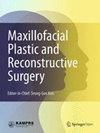Changes in the pharyngeal airway after different orthognathic procedures for correction of class III dysplasia
IF 2
Q2 DENTISTRY, ORAL SURGERY & MEDICINE
Maxillofacial Plastic and Reconstructive Surgery
Pub Date : 2022-06-09
DOI:10.1186/s40902-022-00352-8
引用次数: 3
Abstract
This study was conducted to compare changes in pharyngeal airway after different orthognathic procedures in subjects with class III deformity. The study included CBCT scans of 48 skeletal class III patients (29 females and 19 males, mean age 23.50 years) who underwent orthognathic surgery in conjunction with orthodontic treatment. The participants were divided into three groups of 16, as follows: Group 1, mandibular setback surgery; group 2, combined mandibular setback and maxillary advancement surgery; and group 3, maxillary advancement surgery. CBCT images were taken 1 day before surgery (T0), 1 day (T1), and 6 months (T2) later. The dimensions of the velopharynx, oropharynx, and hypopharynx were measured in CBCT images. In all groups, there was a significant decrease in airway variables immediately after surgery, with a significant reversal 6 months later (P < 0.05). In subjects who underwent maxillary advancement, the airway dimensions were significantly greater at T2 than the T0 time point (P < 0.05), whereas in the mandibular setback and bimaxillary surgery groups, the T2 values were lower than the baseline examination (P < 0.05). The alterations in airway variables were significantly different between the study groups (P < 0.05). The mandibular setback procedure caused the greatest reduction in the pharyngeal airway, followed by the bimaxillary surgery and maxillary advancement groups, with the latter exhibiting an actual increase in the pharyngeal airway dimensions. It is recommended to prefer a two-jaw operation instead of a mandibular setback alone for correction of the prognathic mandible in subjects with predisposing factors to the development of sleep-disordered breathing.矫正III类发育不良的不同正颌手术后咽气道的变化
本研究旨在比较III类畸形患者在不同的正颌手术后咽气道的变化。该研究包括48例骨骼III级患者的CBCT扫描(29名女性和19名男性,平均年龄23.50岁),他们接受了正颌手术和正畸治疗。参与者分为三组,每组16人,分别为:第一组,下颌退缩手术;第2组:下颌后退+上颌前进联合手术;第三组,上颌前移手术。术前1天(T0)、术后1天(T1)、术后6个月(T2)分别取CBCT图像。在CBCT图像中测量腭咽、口咽和下咽的尺寸。两组患者术后气道各项指标均显著下降,6个月后出现显著逆转(P < 0.05)。上颌前进组患者T2时气道尺寸明显大于T0时(P < 0.05),而下颌骨后退组和双颌手术组患者T2值低于基线检查(P < 0.05)。两组间气道变量变化差异有统计学意义(P < 0.05)。下颌后退手术导致咽气道最大的缩小,其次是双颌手术组和上颌推进组,后者显示出咽气道尺寸的实际增加。对于有睡眠呼吸障碍易感因素的患者,建议采用双颌手术而不是单独的下颌骨退缩来矫正下颌骨前突。
本文章由计算机程序翻译,如有差异,请以英文原文为准。
求助全文
约1分钟内获得全文
求助全文
来源期刊

Maxillofacial Plastic and Reconstructive Surgery
DENTISTRY, ORAL SURGERY & MEDICINE-
CiteScore
4.30
自引率
13.00%
发文量
37
审稿时长
13 weeks
 求助内容:
求助内容: 应助结果提醒方式:
应助结果提醒方式:


